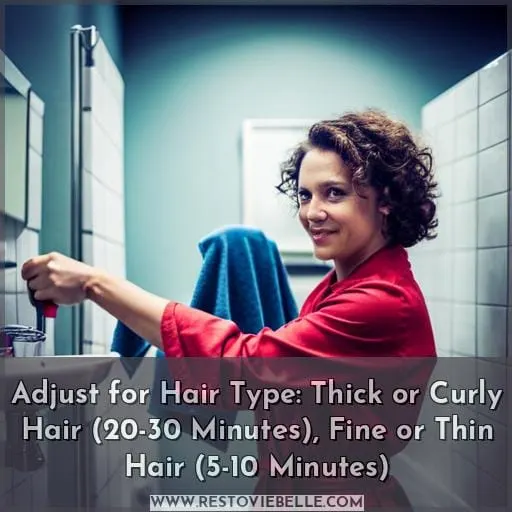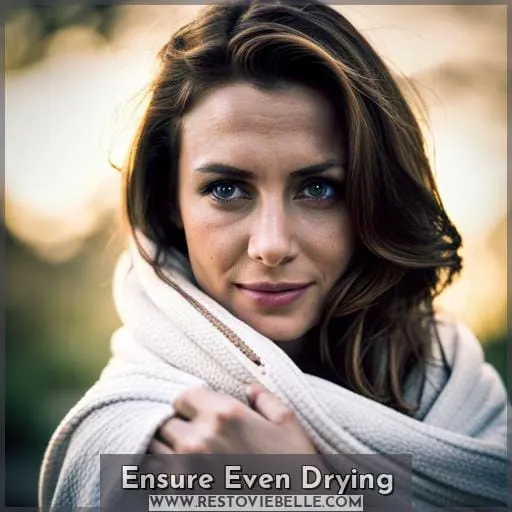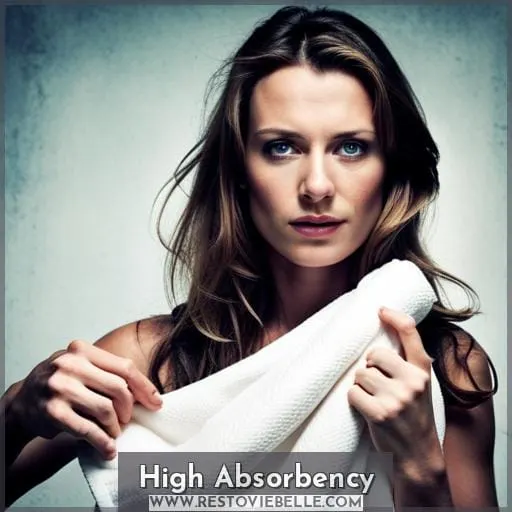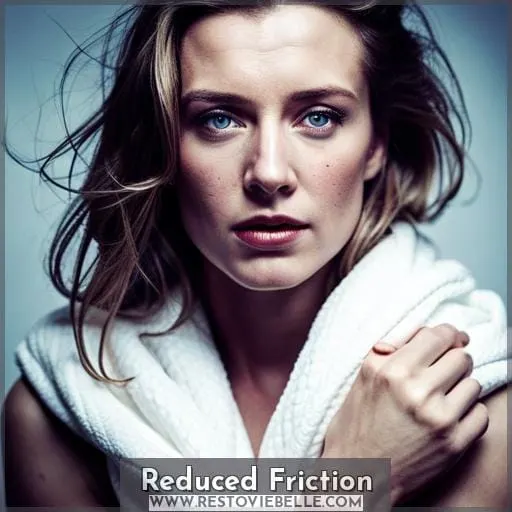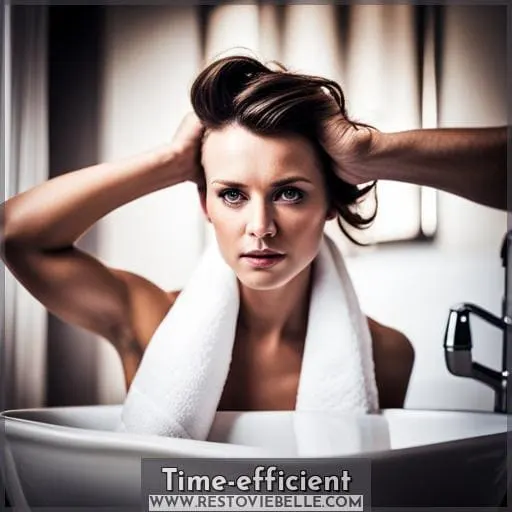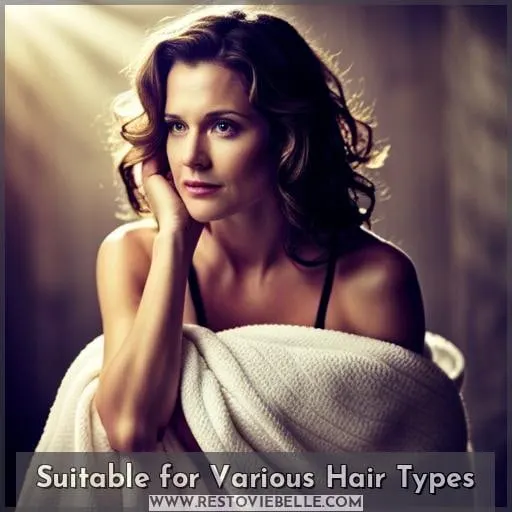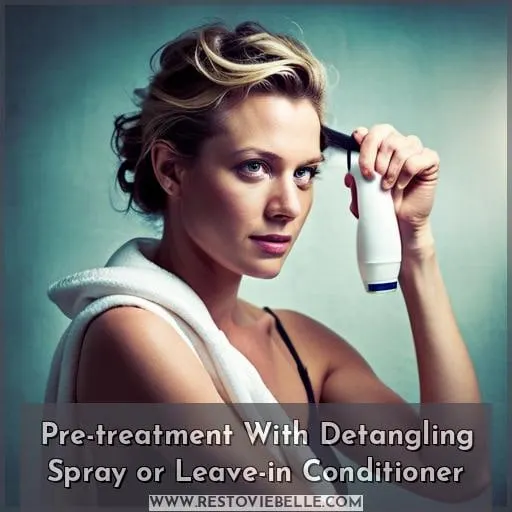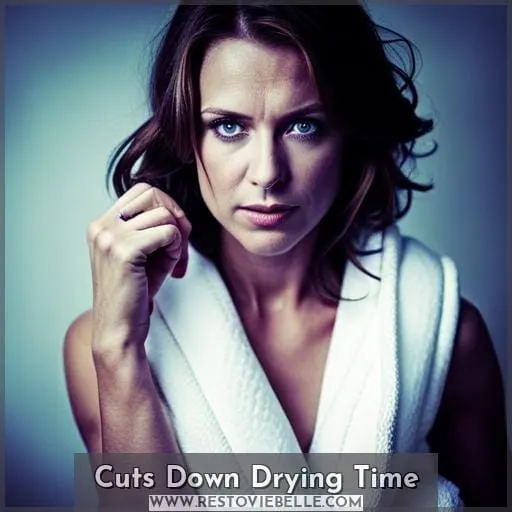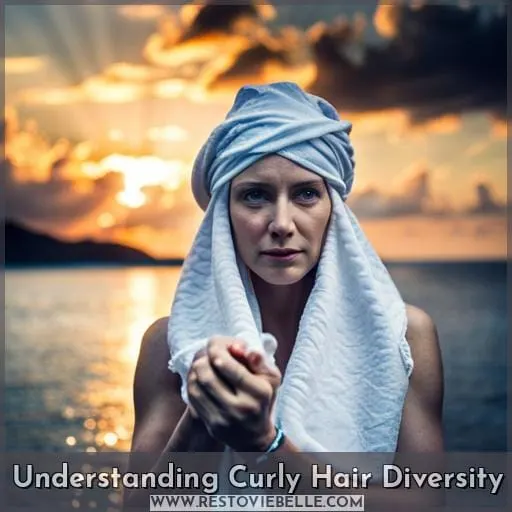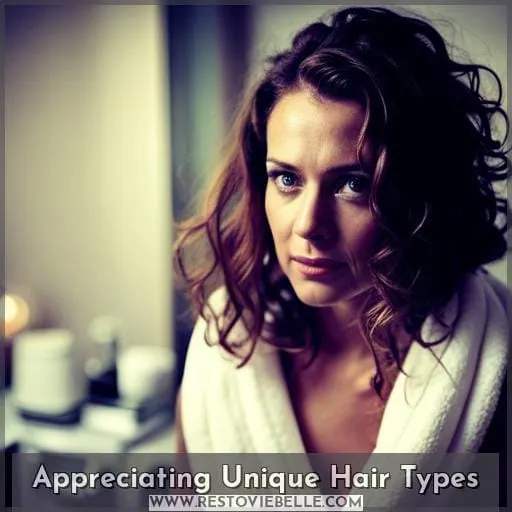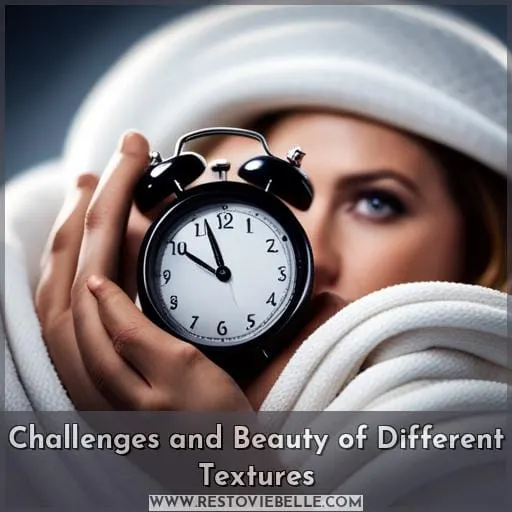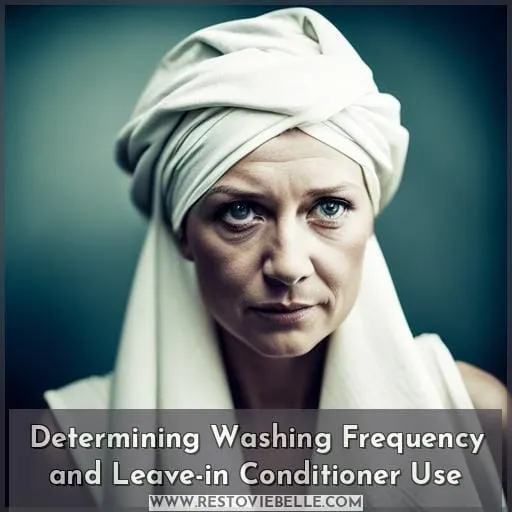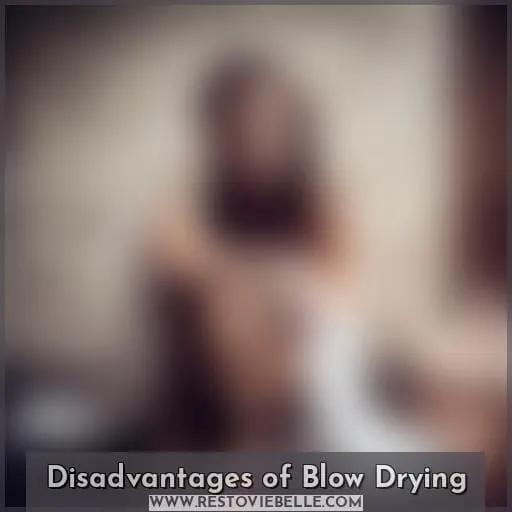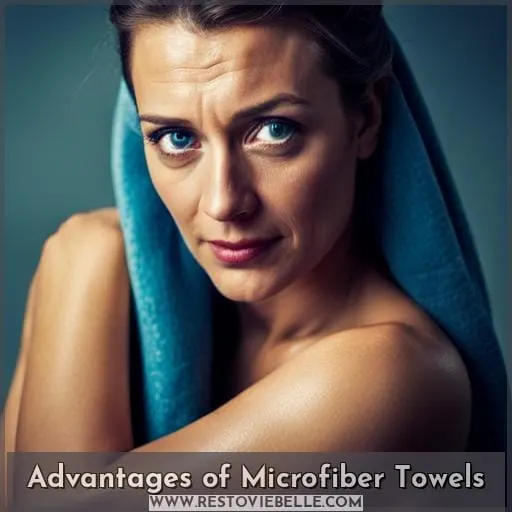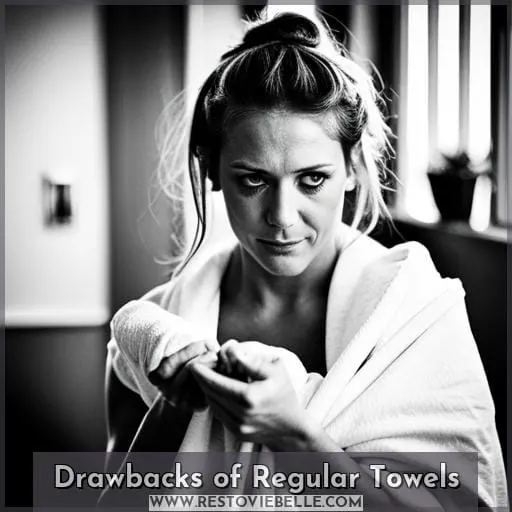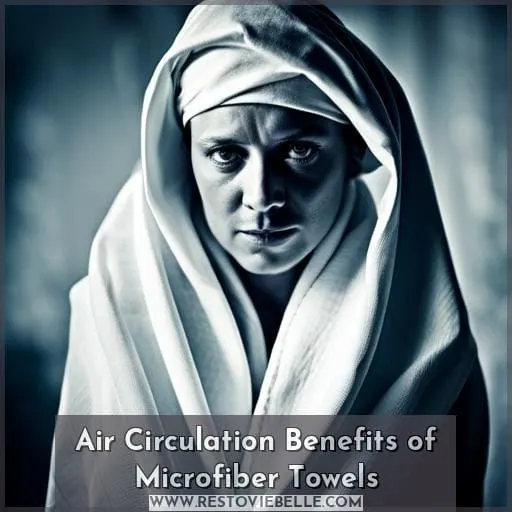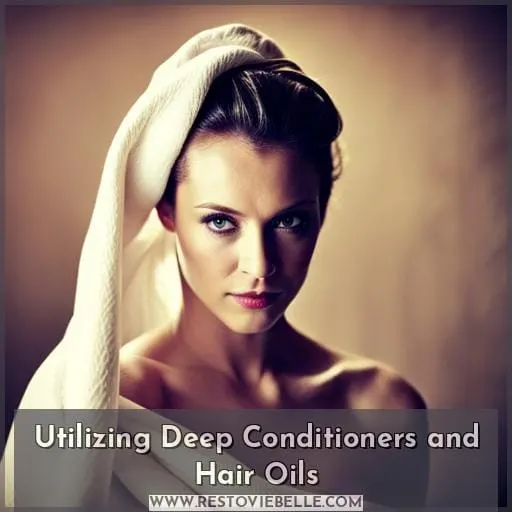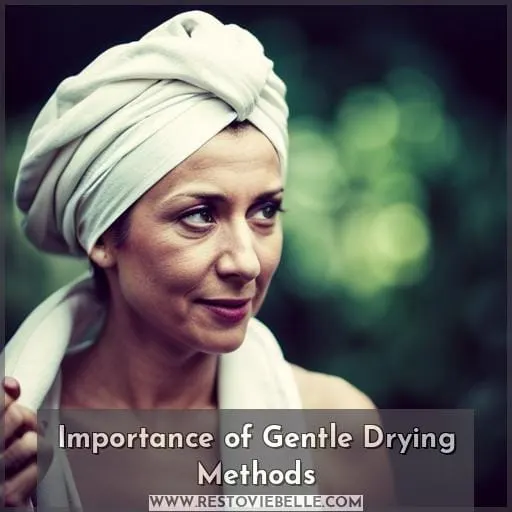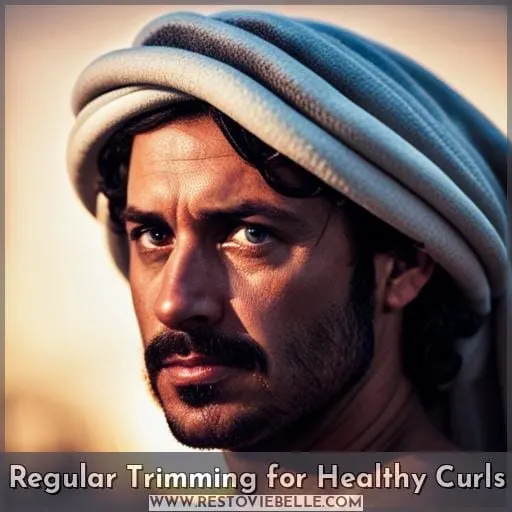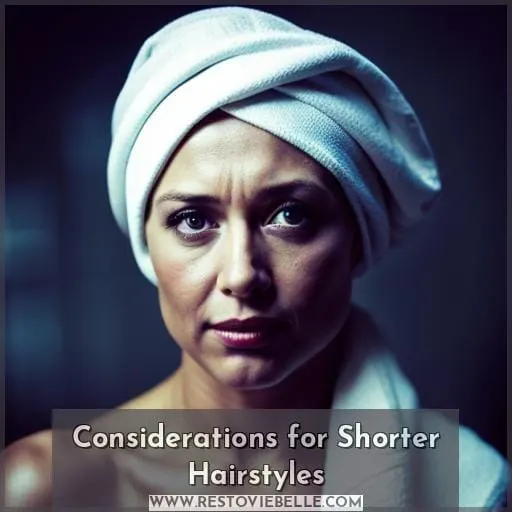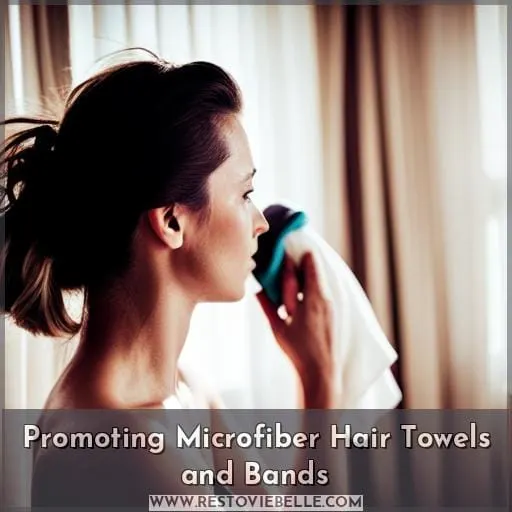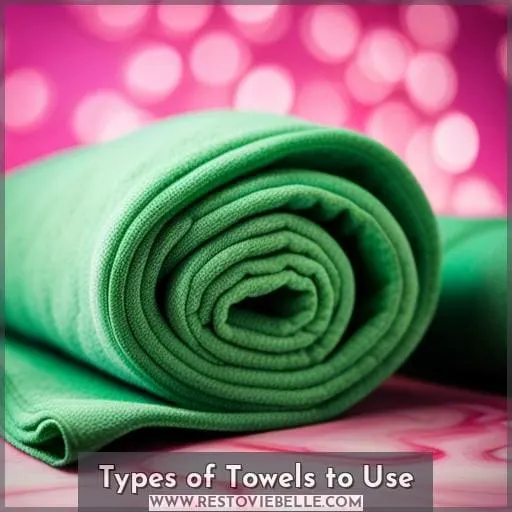This site is supported by our readers. We may earn a commission, at no cost to you, if you purchase through links.
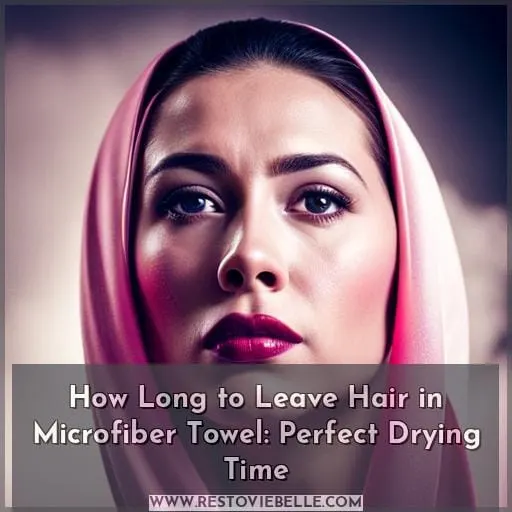 Ready to achieve the perfect drying time for your hair? Say goodbye to frizz and damage with a microfiber towel. Wondering how long you should leave your hair in it? Look no further! In this article, we’ll guide you through the optimal duration for different hair types, ensuring even drying without over-drying.
Ready to achieve the perfect drying time for your hair? Say goodbye to frizz and damage with a microfiber towel. Wondering how long you should leave your hair in it? Look no further! In this article, we’ll guide you through the optimal duration for different hair types, ensuring even drying without over-drying.
Discover the benefits of using microfiber towels and follow our expert tips for maximum results. It’s time to take control of your hair care routine and enjoy healthier, more beautiful locks.
Table Of Contents
- Key Takeaways
- General Recommendation: 10-15 Minutes
- Adjust for Hair Type: Thick or Curly Hair (20-30 Minutes), Fine or Thin Hair (5-10 Minutes)
- Prevent Frizz and Damage
- Ensure Even Drying
- Avoid Over-drying
- High Absorbency
- Reduced Friction
- Time-efficient
- Suitable for Various Hair Types
- Overall Improvement in Hair Health
- Post-wash Use
- Gentle Handling
- Pre-treatment With Detangling Spray or Leave-in Conditioner
- Stick to Recommended Duration
- Follow Guidelines for Optimal Results
- Reduces Damage and Breakage
- Cuts Down Drying Time
- Try the Recommended Duration for Positive Effects
- Additional Tips for Maximizing Benefits
- Understanding Curly Hair Diversity
- Appreciating Unique Hair Types
- Challenges and Beauty of Different Textures
- Selecting Appropriate Hair Care Products
- Determining Washing Frequency and Leave-in Conditioner Use
- Experimenting With Different Products
- Nighttime Care Practices
- Disadvantages of Blow Drying
- Advantages of Microfiber Towels
- Drawbacks of Regular Towels
- Air Circulation Benefits of Microfiber Towels
- Utilizing Deep Conditioners and Hair Oils
- Proper Application Process
- Consistent Deep Conditioning
- Specialized Care for Dry or Dyed Hair
- Importance of Gentle Drying Methods
- Regular Trimming for Healthy Curls
- Considerations for Shorter Hairstyles
- Consulting With a Stylist
- Promoting Microfiber Hair Towels and Bands
- Types of Towels to Use
- Techniques Like Blotting and Squeezing
- The Towel Wrap and Plopping Methods
- Frequently Asked Questions (FAQs)
- How do microfiber towels compare to regular towels in terms of absorbency?
- Can using a microfiber towel reduce frizz in all hair types?
- Are there any specific care guidelines for washing microfiber towels?
- How does using a microfiber towel contribute to overall hair health and appearance?
- Can using a microfiber towel help to enhance the texture of the hair?
- Conclusion
Key Takeaways
- General recommendation: 10-15 minutes; Adjust for hair type.
- Tailor drying time based on hair thickness and texture.
- Use gentle patting, avoid rubbing, and consider alternative drying methods (air drying, diffusing).
- Ensure even drying for all strands and prevent over-drying to maintain moisture.
General Recommendation: 10-15 Minutes
For optimal results, leave your hair in a microfiber towel for 10-15 minutes.
Adjusting the duration based on your hair texture is crucial to prevent over-drying or frizz.
Thick or curly hair can benefit from an extended time of 20-30 minutes, ensuring even drying and minimizing frizz.
On the other hand, fine or thin hair may only need 5-10 minutes to avoid excessive dryness and brittleness.
The absorbent material of microfiber towels allows them to efficiently soak up moisture while reducing friction on the strands, promoting healthier-looking locks.
By following this general recommendation and considering your specific hair type, you can achieve optimal towel usage that improves both drying time and overall hair health.
Adjust for Hair Type: Thick or Curly Hair (20-30 Minutes), Fine or Thin Hair (5-10 Minutes)
Now that you’re familiar with the general recommendation of leaving your hair in a microfiber towel for 10-15 minutes, it’s time to delve into how you can adjust this drying time based on your specific hair type.
Hair type considerations play a crucial role in determining the optimal drying time to achieve frizz-free and healthy-looking locks.
- Thick or Curly Hair (20-30 Minutes):
If you have thick or curly hair, it’s recommended to leave your hair wrapped in a microfiber towel for 20-30 minutes. This extended duration allows for more even drying and helps prevent frizz by minimizing friction and damage.
- Fine or Thin Hair (5-10 Minutes):
On the other hand, if you have fine or thin hair, reducing the drying time is essential to avoid over-drying which can lead to excessive dryness and brittleness. Leaving your hair wrapped in a microfiber towel for just 5-10 minutes should be sufficient.
Remember that these recommendations aren’t set in stone – every individual’s hair may vary slightly. For personalized advice tailored specifically to your unique needs, consider consulting with a stylist who can provide expert guidance on optimal toweldrying methods based on their knowledge of differenthair typesand effectivefrizz prevention techniques.
Prevent Frizz and Damage
To prevent frizz and damage, you should handle your hair gently while using a microfiber towel.
Microfiber towels are designed to minimize friction and reduce the risk of breakage, making them an excellent choice for preventing frizz.
When drying your hair with a microfiber towel, avoid rubbing or twisting it aggressively as this can lead to tangles and potential damage. Instead, gently blot or squeeze out excess moisture from your strands using the towel’s absorbent properties.
Additionally, consider factors such as optimal duration based on your hair type considerations. Thick or curly hair may benefit from leaving the towel on for 20-30 minutes to ensure even drying without over-drying the strands.
On the other hand, fine or thin hair might only need 5-10 minutes in order to retain adequate moisture without causing brittleness.
For further advice tailored specifically to your unique needs and concerns regarding frizz prevention techniques and overall hairstyling strategies that promote healthy locks while utilizing a microfiber towel effectively, consult with a professional stylist who can provide expert guidance aligned with achieving desirable results while maintaining long-term moisture retention goals ensuring maximum longevity of both quality products like our premium-grade microfiber towels alongsidetowel longevity itself.
Ensure Even Drying
To ensure even drying, adjust the amount of time you leave your hair in a microfiber towel based on its thickness and texture.
Thick or curly hair may require 20-30 minutes, while fine or thin hair may only need 5-10 minutes.
By tailoring the duration to your specific needs, you can prevent frizz and achieve optimal results.
Even drying techniques are essential for maintaining healthy and frizz-free hair.
Consider using different towel wrap methods to evenly distribute moisture throughout your strands.
This will help minimize any areas that might still be damp after removing the towel.
By incorporating these considerations into your hair care routine, you can ensure that each strand receives equal attention during the drying process, resulting in beautifully dried and styled locks every time.
Avoid Over-drying
To avoid over-drying your hair, make sure to leave it in the microfiber towel for the recommended duration. Over-drying can lead to excessive dryness and brittleness, causing damage to your hair.
Here are some tips to prevent over-drying:
- Follow optimal drying times: Different hair types require different lengths of time in the towel wrap or plopping technique.
- Use frizz prevention techniques: Avoid rubbing or twisting your hair while it’s wrapped in a microfiber towel as this can cause friction and contribute to frizziness.
- Choose a high-quality microfiber towel: Opt for towels made from fine fibers that have superior moisture absorption capabilities.
- Consider using alternative drying methods: If you find that leaving your hair in a microfiber towel for the recommended duration still leaves it too dry, consider trying other gentle drying methods like air drying or diffusing with low heat.
By following these tips, you can ensure that you’re not over-drying your hair and maintaining its health and appearance.
High Absorbency
With its high absorbency, a microfiber towel quickly soaks up excess moisture from your hair. This enhanced absorption is one of the key benefits of using a microfiber towel for drying your hair. Unlike traditional towels that simply move water around, the fine fibers in a microfiber towel attract and trap water molecules, resulting in more efficient drying.
The optimal drying time with a microfiber towel helps prevent frizz and damage while ensuring even drying across different hair types. Thick or curly hair may benefit from leaving the towel on for 20-30 minutes to allow for thorough drying, while fine or thin hair may only need 5-10 minutes to avoid over-drying.
Considering your specific hair type when managing time with a microfiber towel will help you achieve optimal results in frizz prevention and overall care management.
Reduced Friction
Avoid rough actions like rubbing or twisting your hair when using a microfiber towel to reduce friction and prevent breakage. Reduced friction has numerous benefits for your hair, including frizz prevention, improved hair health, and enhanced appearance.
Here are four key points on how reduced friction can benefit your hair:
- Hair Benefits: By minimizing strain and breakage caused by rough actions, such as rubbing or twisting with a regular towel, reduced friction helps maintain the integrity of your strands.
- Frizz Prevention: The gentle nature of microfiber towels reduces frizziness without the need for additional products or treatments.
- Towel Techniques: Adopting proper techniques like blotting instead of vigorous rubbing can further minimize friction while drying your hair with a microfiber towel.
- Stylist Recommendations: Many hairstylists recommend using microfiber towels due to their ability to reduce damage from excessive manipulation during drying.
Time-efficient
Save time in your hair care routine by using a microfiber towel for quick and efficient drying.
Microfiber towels are known for their high absorbency, making them the perfect tool to cut down on drying time.
With optimal absorption capabilities, these towels effectively remove excess water from your hair, allowing it to dry faster than traditional towels.
This time-efficient method not only saves you valuable minutes but also helps prevent frizz and damage caused by excessive rubbing or heat exposure from blow-drying.
By incorporating a microfiber towel into your routine, you can achieve efficient drying while promoting hair health and managing frizz control effortlessly.
For even better results, consider using leave-in conditioner before toweling to reduce friction and ease combing through wet strands.
Embrace the power of effective time management in your hairstyling journey with this simple yet highly beneficial addition – the microfiber towel.
Suitable for Various Hair Types
Are you wondering which hair types can benefit from using a microfiber towel? The answer is: all hair types! Whether you have straight, wavy, curly, or kinky hair, a microfiber towel is suitable for your needs.
- Hair Texture Diversity: Microfiber towels work well with different textures and help retain moisture.
- Styling Techniques: From air-drying to plopping and diffusing curls, the towel aids in achieving desired styles.
- Curly Haircare: Microfiber towels minimize frizz and promote healthier curls by reducing breakage during drying.
- Moisture Retention: These towels are highly absorbent while being gentle on the strands.
Regardless of your hair type or styling preferences, incorporating a microfiber towel into your routine will enhance moisture retention and overall hair health. So say goodbye to traditional cotton towels that may cause friction and hello to the benefits of using a microfiber towel for optimal drying time.
Overall Improvement in Hair Health
Not only does using a microfiber towel for drying your hair save you time and reduce frizz, but it also contributes to the overall improvement in your hair health.
The fine fibers of the microfiber towel gently absorb excess moisture from your strands, promoting curl definition and enhancing texture. By minimizing friction and breakage, this innovative towel helps retain moisture in your hair, preventing dryness and brittleness.
Incorporating a deep conditioner or hair oil into your natural hair routine can further enhance these benefits by repairing damaged strands and promoting healthy growth.
With regular use of a microfiber towel alongside proper care techniques like gentle handling and optimal drying times, you’ll notice:
- Reduced breakage
- Improved curl definition
- Enhanced texture
- Increased moisture retention
All leading to healthier-looking locks that showcase their natural beauty.
Post-wash Use
After washing your hair, immediately apply the microfiber towel to absorb excess water and speed up the drying process.
Post-wash use of a microfiber towel offers numerous benefits for your hair. It helps maintain optimal drying time while preventing frizz and damage.
By gently blotting and squeezing your hair with the microfiber towel, you can prevent breakage caused by rough actions like rubbing or twisting. This gentle technique also reduces friction, leading to smoother strands and improved overall hair health.
Additionally, using a microfiber towel post-wash enhances the effectiveness of any leave-in conditioners or styling products you may apply afterwards by allowing them to penetrate more effectively into damp strands without excessive moisture loss.
Incorporating this simple yet effective tool into your routine will contribute to healthier-looking locks with reduced frizz and improved texture.
Gentle Handling
Now that you know the optimal time to leave your hair in a microfiber towel, it’s crucial to understand the importance of gentle handling. Treating your hair with care during drying can prevent frizz, promote hair health, and ensure optimal results.
Here are some tips for incorporating gentle towel techniques into your routine:
- Avoid rough actions: Instead of vigorously rubbing or twisting your hair with the towel, gently blot or squeeze out excess water.
- Use a wide-tooth comb or brush: After removing the microfiber towel from your hair, use a wide-tooth comb or brush designed for wet hair to gently detangle without causing breakage.
- Apply conditioner before plopping: If you prefer plopping as a styling method after using the microfiber towel, apply leave-in conditioner beforehand to reduce friction and make combing easier later on.
By following these guidelines for gentle handling while drying with a microfiber towel and incorporating suitable styling techniques like brushing and conditioning properly,promoting better overallhair health will be achieved.
Pre-treatment With Detangling Spray or Leave-in Conditioner
To ensure a smooth and tangle-free drying experience, enhance the effectiveness of your microfiber towel by pre-treating your hair with a detangling spray or leave-in conditioner. These products work their magic by providing conditioning bliss and acting as frizz fighters while also offering quick absorption into the hair strands.
By incorporating this step into your routine, you can optimize the benefits of using a microfiber towel for drying time reduction and gentler handling.
The table below highlights some key characteristics of detangling sprays and leave-in conditioners:
| Product | Benefits |
|---|---|
| Detangling Spray | – Eases combing through tangled hair |
| – Reduces breakage during drying process | |
| – Provides instant softness and manageability |
Leave-in Conditioner
By incorporating these products before using your microfiber towel to dry your hair, you can enjoy smoother results with minimal tangles or knots. This additional step ensures that not only will you have quicker drying time but also softer, more manageable locks in no time at all.
Stick to Recommended Duration
Make sure you stick to the recommended duration when leaving your hair in a microfiber towel.
The optimal duration for drying your hair with a microfiber towel is typically around 10-15 minutes. However, it’s important to consider your hair type when determining the exact time needed.
If you have thick or curly hair, you may need to leave your hair in the towel for 20-30 minutes to ensure even drying and prevent frizz.
On the other hand, if you have fine or thin hair, a shorter duration of 5-10 minutes will suffice to avoid over-drying and brittleness.
By following these guidelines and considering factors such as frizz prevention and drying efficiency based on your specific needs, you can make the most out of using a microfiber towel for drying straight or curly locks without causing damage.
Follow Guidelines for Optimal Results
To achieve the best results, follow these guidelines for optimal hair drying with a microfiber towel:
- Master the towel wrap techniques:
- Learn how to properly wrap your hair in a microfiber towel to maximize absorption and minimize frizz.
- Experiment with different wrapping methods to find what works best for your hair type.
- Explore plopping method variations:
- Plopping is a technique that involves using a microfiber towel or T-shirt to create defined curls while drying.
- Try different variations of plopping, such as using clips or diffusers, to enhance your natural curl pattern.
- Incorporate overnight care routines:
- Overnight treatments can provide deep hydration and nourishment for your hair while you sleep.
- Consider applying DIY hair treatments before bed and wrapping your head with a microfiber towel or silk scarf for enhanced absorption.
By following these guidelines, you can optimize the benefits of using a microfiber towel in your hair care routine and achieve healthier-looking locks.
Reduces Damage and Breakage
When it comes to drying your hair, reducing damage and breakage should be a top priority.
The fine fibers of microfiber towels create reduced friction compared to traditional towels, resulting in gentler treatment of your hair. This helps prevent breakage and damage that can occur from rough towel drying methods.
In addition to reducing damage and breakage, using a microfiber towel also contributes to overall hair health by preventing frizz and improving the appearance of your locks. By opting for this gentle alternative, you can enhance the texture of your hair while avoiding reliance on additional products.
By incorporating microfiber towels into your routine with optimal duration (10-15 minutes), you can achieve not only efficient drying but also healthier-looking locks without compromising its natural beauty or spending excessive time styling it afterwards.
| Benefits | ||
|---|---|---|
| Reduced Friction | Optimal Duration | Frizz Prevention |
| Hair Health | Styling Techniques | haircuts for curlyhair,hair dye,wavyhair,tips formen,lint attraction |
Cuts Down Drying Time
Cut your drying time in half by using a microfiber towel.
This versatile tool absorbs more water than traditional towels, making it perfect for speeding up the drying process.
Not only does it save you time, but it’s also gentler on your hair compared to rougher towels or the heat from a blow dryer.
By reducing friction and minimizing strain, using a microfiber towel improves hair health and reduces breakage over time.
Additionally, its high absorbency ensures even drying throughout your strands for an overall smoother and softer feel.
Incorporating this simple change into your routine can make a significant difference in achieving faster dry times without compromising the health of your hair.
- Absorbs more water
- Gentler on hair
- Saves time
- Versatile tool
- Improves hair health
Try the Recommended Duration for Positive Effects
Now that you know the recommended duration for leaving your hair in a microfiber towel, it’s time to try it out and experience the positive effects. By following these guidelines, you can effectively dry your hair while preventing frizz, reducing damage, saving time, and treating your hair with gentle care.
To help you understand the benefits of trying the recommended duration for drying your hair with a microfiber towel, take a look at this table:
| Benefits | Effects |
|---|---|
| Dry Hair | Absorbs moisture efficiently |
| Prevent Frizz | Minimizes friction and reduces frizziness |
| Reduce Damage | Decreases strain on strands |
| Save Time | Cuts down on drying time |
| Gentle Hair – Reduces breakage risk |
By adhering to the suggested timeframe (10-15 minutes), you’ll achieve optimal results without over-drying or causing any undue damage. Remember to follow all recommendations provided throughout this article for maximum benefits when incorporating a microfiber towel into your hair care routine.
Additional Tips for Maximizing Benefits
To maximize the benefits of using a microfiber towel for drying your hair, there are some additional tips you can follow:
First, make sure to apply the towel immediately after washing your hair to absorb excess water and speed up the drying process.
Secondly, handle your hair gently when using the towel by avoiding rough actions like rubbing or twisting that can cause damage and breakage.
Lastly, consider pre-treating your hair with a detangling spray or leave-in conditioner before toweling to reduce friction and make combing easier.
Optimal hair towel duration
To maximize the benefits of using a microfiber towel, it’s important to determine the optimal duration for leaving your hair wrapped in it.
- Consider your hair type and adjust accordingly
- Prevent frizz and damage by minimizing friction
- Ensure even drying for thick or curly hair
- Avoid over-drying fine or thin hair
- Consult with a stylist for personalized recommendations.
Benefits of microfiber towels
For optimal results, incorporate these additional tips to maximize the benefits of using a microfiber towel.
Microfiber towels offer numerous advantages for hair care, including high absorbency and reduced friction. They’re time-efficient and suitable for various hair types, promoting overall improvement in hair health.
To make the most out of your microfiber towel, consider:
- Post-wash use
- Gentle handling techniques
- Pre-treatment with detangling spray or leave-in conditioner
- Sticking to recommended drying durations based on your hair type (thick/curly or fine/thin)
- Following guidelines for optimal results in your styling routine.
Tips for using microfiber towel
Follow these additional tips to maximize the benefits of using a microfiber towel for drying your hair:
- Towel Techniques:
- Instead of rubbing, gently blot or squeeze your hair with the microfiber towel to minimize friction and prevent damage.
- Drying Strategies:
- Wrap your hair in the towel or use plopping method for optimal absorption and even drying.
- Hair Towel Tips:
- Consider purchasing multiple microfiber towels to always have a clean one on hand, and wash them separately from cotton towels to maintain their absorbency.
By following these tips, you can master the art of using a microfiber towel for perfectly dried and healthy-looking hair in no time!
Understanding Curly Hair Diversity
As you delve into understanding curly hair diversity, it’s important to appreciate the uniqueness of different curl patterns and textures.
Each individual’s curls tell a story, from loose waves to tight coils.
Curl confidence comes from embracing and celebrating these natural variations in hair texture.
Texture tales abound with stories of self-discovery and acceptance as individuals learn how to care for their specific curl type.
From product picks tailored for different textures to style showcases that highlight the beauty of each unique pattern, there are endless possibilities when it comes to curly hair care tips.
So whether you have bouncy ringlets or voluminous spirals, remember that your curls are a beautiful expression of who you are—embrace them with pride!
Appreciating Unique Hair Types
Now, let’s delve into the diverse world of hair types and appreciate the uniqueness that each one brings.
- Curl Confidence: From loose waves to tight coils, every curl pattern tells a story. Embrace your natural texture and find confidence in embracing your unique curls.
- Texture Tales: Each individual’s hair has its own tale to tell through its texture – whether it’s silky smooth or full of bounce and volume. Embrace the beauty of your specific texture and learn how to enhance its natural characteristics.
- Frizz Fighters: Frizz can be a common challenge for many hair types, but there are ways to combat it! Discover techniques, products, and styling methods that will help you tame frizz and achieve smoother locks.
Appreciating unique hair types allows us all to celebrate our individuality while finding harmony in our own personal style stories.
Challenges and Beauty of Different Textures
You may have noticed that different hair textures present unique challenges and showcase their own beauty. From straight to kinky, each curl pattern comes with its own set of texture challenges that require specific styling techniques and frizz management strategies.
Understanding the intricacies of your hair’s texture can help you embrace its natural beauty and find effective ways to care for it.
To give you a better understanding, here is a table highlighting some common curl patterns along with their corresponding challenges and tips for managing them:
| Curl Pattern | Texture Challenges | Styling Techniques |
|---|---|---|
| Straight | Lack of volume | Use volumizing products |
| Wavy | Inconsistent waves | Enhance curls with mousse |
| Curly | Frizz-prone | Enhance definition with gel |
| Kinky | Dryness | Moisturize regularly |
By identifying the unique characteristics of your hair’s texture and implementing appropriate styling techniques, you can overcome any challenges while embracing the natural beauty that comes with your specific curl pattern.
Selecting Appropriate Hair Care Products
When it comes to selecting appropriate hair care products, understanding your hair type is essential. Different hair types have different needs and require specific products for optimal results. Additionally, knowing the optimal drying time when using a microfiber towel is crucial in order to prevent over-drying or under-drying your hair.
By considering these factors and utilizing the benefits of microfiber towels, you can enhance your overall hair health and appearance effectively.
Hair type considerations
When considering how long to leave your hair in a microfiber towel, it’s important to take into account the specific needs of your hair type and select appropriate hair care products.
- Hair Texture Insights: Understand the unique characteristics of your hair texture.
- Drying Time Variations: Different textures require varying durations for optimal drying.
- Frizz Control Techniques: Choose products that help control frizz and promote smoothness.
- Optimal Towel Duration: Find the right balance between thorough drying and avoiding over-drying.
- Hair Health Considerations: Consider how towel usage can impact the overall health of your hair.
Optimal drying time
To ensure optimal results when using a microfiber towel, it’s important to consider the appropriate drying time based on your hair type and the hair care products you use.
Achieving perfect timing for drying your hair with a microfiber towel can help prevent frizz, promote overall hair health, and maximize drying efficiency.
By finding the optimal duration for your specific needs, you can achieve the best possible results in terms of frizz prevention and maintaining healthy-looking hair.
Benefits of microfibe
Get ready to experience the amazing benefits of microfiber towels for your hair by selecting the right hair care products.
Microfiber towel benefits include:
- High absorbency
- Reduced friction
- Time efficiency
These towels are suitable for various hair types, improving overall hair health and appearance.
Incorporating microfiber towels into your routine can:
- Enhance drying techniques
- Promote healthier styling practices
- Contribute to better hair health
When choosing a towel, opt for a high-quality microfiber option that will provide optimal results in terms of absorption and gentleness on your tresses.
Determining Washing Frequency and Leave-in Conditioner Use
To properly determine the washing frequency and use of leave-in conditioner, consider your hair type and specific needs.
Washing frequency depends on factors like oiliness, sweat accumulation, styling products used, and environmental conditions.
Generally, it’s recommended to wash your hair every 2-3 days for normal or dry hair types.
However, if you have oily scalp or work out frequently, you may need to wash more often.
On the other hand,
if you have curly or coily hair that tends to be drier,
washing less frequently can help retain natural oils.
As for leave-in conditioner usage,
it can benefit all hair types by providing extra moisture
and protection throughout the day.
Apply a small amount of product evenly through damp
or towel-dried hair after washing.
Experiment with different brands and formulas
to find one that suits your specific needs.
For personalized advice on washing frequency
and suitable products,
consult with a professional stylist who can assess your individual requirements accurately.
Experimenting With Different Products
Now that you have established the optimal washing frequency and leave-in conditioner use for your hair, it’s time to dive into the exciting world of experimenting with different products.
Hair care innovation has come a long way, offering an array of options for texture enhancement, moisture retention, and styling versatility. By incorporating new products into your routine, you can take your hair care game to the next level.
Product experimentation allows you to discover what works best for your unique hair type and goals. Whether it’s trying out a new shampoo or conditioner specifically formulated for curly or damaged hair or exploring innovative treatments like serums or masks designed to nourish and repair strands from within—there are endless possibilities.
Keep in mind that not every product will yield immediate results; finding what works may require some trial-and-error. Embrace this opportunity as a chance to gain mastery over caring for your locks while liberating yourself from any limitations in achieving healthy-looking tresses.
Nighttime Care Practices
Continue caring for your curls at night by incorporating these essential nighttime care practices.
To protect your hair while you sleep, consider investing in satin pillowcases or silk scarves. These smooth materials minimize friction and reduce the risk of breakage and frizz.
Additionally, using overnight masks can provide deep hydration and nourishment to your locks as you rest, promoting healthier hair in the morning.
Hair bonnets or satin caps are also excellent options to keep your curls intact throughout the night and prevent tangles while preserving moisture levels.
By implementing these nighttime care practices, you’ll wake up with refreshed and manageable curls that are ready to take on the day ahead with confidence.
Disadvantages of Blow Drying
After incorporating nighttime care practices to prevent morning frizz, it’s time to explore the disadvantages of blow drying your hair.
- Heat damage: Blow dryers emit high heat, which can lead to permanent damage and weaken your hair over time.
- Frizz promotion: The rapid airflow from a blow dryer can disturb the cuticle layer of your hair, causing frizziness and flyaways.
- Over-drying: Blow drying for too long or at high temperatures can strip away moisture from your strands, leaving them dry and brittle.
- Lack of professional guidance: Without consulting a stylist or expert in hairstyling techniques, you may not be using the correct settings or products for optimal results.
To minimize these risks and maintain healthy hair, consider using microfiber towels as an alternative method for faster yet gentler drying. Additionally, seek advice from a stylist who can provide personalized recommendations based on your specific hair type and needs.
Advantages of Microfiber Towels
To further enhance your hair drying experience, let’s explore the advantages of using microfiber towels.
Microfiber towels offer gentle care and quick absorption, making them an ideal choice for drying your hair. Compared to traditional towels, microfiber towels have a larger surface area due to their fine fibers, allowing them to absorb moisture more efficiently.
This not only reduces drying time but also helps prevent frizz by minimizing friction and strain on your hair. Additionally, these towels are durable and easy to maintain since they can endure around 500 washes without losing their effectiveness.
By using microfiber towels regularly in your hair care routine, you can promote overall hair health while saving time in the process.
| Advantages of Microfiber Towels |
|---|
| Gentle Care |
| Quick Absorption |
| Frizz Prevention |
| Hair Health |
| Time Efficiency |
Table: The Advantages of Using Microfiber Towels
Drawbacks of Regular Towels
One drawback of using regular towels for drying your hair is that they can rapidly wick away moisture, leading to frizz and damage.
Unlike microfiber towels, which are designed with fine fibers that have a larger surface area for superior absorption, traditional towels tend to be rougher and more abrasive on the hair cuticle.
Additionally, regular towels don’t have the same ability to retain moisture as microfiber towels do, resulting in longer drying times and potentially leaving your hair damp or even wet at the roots.
To avoid these issues and promote healthier looking locks, it’s important to consider alternative options like microfiber towel material when it comes to choosing a towel for your hair drying techniques.
Furthermore,taking care of your towl is essential so you should follow some simple tips such as washing separately from cotton ones due tu lint attractionand avoiding fabric softeners since this could affect its absorbency properties
Air Circulation Benefits of Microfiber Towels
When it comes to drying your hair with a microfiber towel, understanding the air circulation benefits is key.
Optimal drying time ensures that air can circulate around your hair, allowing it to dry evenly and reducing the risk of frizz.
Additionally, using a microfiber towel promotes healthier hair by minimizing friction and breakage.
By incorporating this technique into your routine, you can achieve quicker drying times while maintaining the health and appearance of your locks.
Optimal drying time
Get the most out of your microfiber towel by leaving it in your hair for the optimal drying time. Customizing duration is key to achieving frizz prevention and maximizing the benefits for different hair types.
Considerations such as thick or curly hair may require longer durations, while fine or thin hair needs shorter ones. Optimal techniques recommended by stylists ensure even drying without over-drying, promoting healthier and more manageable locks.
Hair health benefits
Experience the hair health benefits of microfiber towels with improved air circulation.
These towels aren’t only efficient in drying your hair, but they also offer advantages such as curl maintenance, frizz control, and enhanced hair texture.
With their gentle yet effective towel techniques, microfiber towels help reduce breakage and promote overall hair health.
Incorporating these styling tips into your routine can lead to healthier and more manageable locks.
Incorporating into routine
To incorporate the air circulation benefits of microfiber towels into your hair care routine, start by using a towel wrap or plopping method after washing to maximize drying efficiency. This technique allows for optimal airflow and helps prevent frizz while promoting hair health.
Consider consulting with a stylist for personalized advice on incorporating microfiber towels into your routine. Perfect timing and proper usage will contribute to achieving the best results in terms of frizz prevention, overall hair health, and styling mastery.
Utilizing Deep Conditioners and Hair Oils
Apply deep conditioners and hair oils to nourish and restore your hair’s health.
Deep conditioning is a vital step in maintaining healthy, hydrated hair. It helps repair damage caused by heat styling, chemical treatments, and environmental factors.
When using a deep conditioner, ensure that you distribute it evenly throughout your strands from roots to ends. Leave the conditioner on for the recommended time specified on the product label or as advised by your hairstylist.
To enhance its effectiveness, you can apply gentle heat with a shower cap or towel wrap to open up the cuticles for better absorption of nutrients.
Hair oils are another excellent tool for rejuvenating dryness and promoting overall hair restoration. Choose an oil suitable for your specific needs – such as argan oil for frizz control or coconut oil for moisture retention – and apply it sparingly from mid-lengths to ends after washing your hair.
While deep conditioning can be performed weekly, hair oils can be used daily or as needed to maintain hydration and treat specific concerns. Consistent deep care with specialized products will lead to noticeable improvements in the texture, appearance, and overall health of your hair.
Additionally, some natural oils like jojoba and olive oil can also help promote the natural color of your hair, giving it a shiny and radiant look.
Proper Application Process
For optimal results, gently wrap your hair in a microfiber towel and leave it on for the recommended duration.
Proper wrapping techniques ensure maximum contact between the towel and your hair, allowing for optimal absorbency and moisture retention.
By using a microfiber towel, you can prevent frizz while promoting overall hair health. The soft fibers of the towel reduce friction, minimizing damage to your strands.
Microfiber towels are known for their high absorbency, effectively removing excess water from your hair without stripping away essential moisture.
Incorporating proper application techniques with a microfiber towel won’t only speed up drying time but also enhance the appearance of your locks by reducing frizz and improving texture.
Consistent Deep Conditioning
For consistent deep conditioning, it’s important to regularly use deep conditioners and hair oils.
Deep conditioning benefits your hair by providing intense hydration, restoring moisture and nourishment, promoting natural color retention, and improving overall hair health.
To maximize the effectiveness of your deep conditioning routine:
- Follow a regular schedule: Incorporate deep conditioning into your weekly or bi-weekly hair care routine.
- Use moisture retention techniques: Apply the conditioner to damp or wet hair for better absorption.
- Properly distribute the product: Ensure that every strand is coated with conditioner using gentle combing or finger detangling methods.
- Enhance results with oil application: Consider incorporating a restorative oil treatment before applying the conditioner for added nourishment and shine.
By consistently implementing these practices in your restorative hair care regimen, you can achieve healthier-looking locks that are hydrated, strong, vibrant in their natural colors while unlocking their true potential.
- Intense Hydration – Penetrates deeply into each strand to replenish lost moisture and restore vitality.
- Restores Moisture Balance – Helps retain essential oils while preventing excessive dryness or greasiness.
Specialized Care for Dry or Dyed Hair
Now that you have learned about consistent deep conditioning for your hair, it’s time to delve into specialized care for dry or dyed hair.
Dry and dyed hair requires extra attention and nourishment to maintain its health, vibrancy, and texture.
Deep hydration is essential to replenish moisture levels in dry strands, while revitalizing treatments can help restore damaged or chemically-treated hair. These treatments lock in moisture and provide lasting shine to keep your locks looking lustrous.
Additionally, special care products designed specifically for colored hair help preserve the vibrant hues while maintaining a healthy texture.
Whether you need intensive repair or color preservation, incorporating these specialized care techniques into your routine will ensure that your dry or dyed locks remain nourished with a radiant glow.
Importance of Gentle Drying Methods
Gently pat your hair dry with a microfiber towel to minimize damage and frizz.
When it comes to drying your hair, using gentle methods is crucial for maintaining its health and appearance.
- Frizz prevention: Gentle drying techniques help reduce friction on the hair strands, preventing frizz from forming.
- Optimal duration: Choosing the right amount of time to leave your hair in the microfiber towel ensures that moisture is retained without over-drying or causing brittleness.
- Hair type considerations: Different hair types require different drying times to achieve optimal results. Thick or curly hair may need longer durations compared to fine or thin hair.
By embracing gentle drying methods and considering your unique hair type, you can help keep your hair looking its best.
Regular Trimming for Healthy Curls
To maintain healthy curls, it’s important for you to regularly trim your hair.
Trimming techniques play a crucial role in curl maintenance by removing split ends and promoting overall hair health.
When considering a haircut, consult with a stylist who specializes in curly hair to ensure they understand the unique needs of your texture. Stylists can provide valuable insight into which haircut considerations will showcase your natural curls best.
Regular trims help prevent breakage and keep the ends of your curls looking fresh and defined. They also promote healthier growth by preventing damage from traveling up the hair shafts.
Embrace the power of regular trimming as part of your curl care routine for liberated, masterful control over your textured tresses.
Considerations for Shorter Hairstyles
If you have shorter hairstyles, it’s essential to consider the optimal drying time when using a microfiber towel.
Hair type plays a significant role in determining how long you should leave your hair in the towel.
For those with fine or thin hair, 5-10 minutes may be sufficient to prevent over-drying and brittleness.
However, for thick or curly hair, extending the duration to 20-30 minutes ensures more even drying and minimizes frizz risk.
Optimal drying time
If you have shorter hairstyles, it’s important to know the optimal drying time for your hair when using a microfiber towel.
Shorter hair tends to dry faster, so leaving it in the towel for too long can lead to over-drying and potential damage.
Aim for a drying time of 5-10 minutes to avoid excessive dryness while still benefitting from the gentle absorption of the microfiber towel.
Consider consulting with a stylist for personalized recommendations based on your specific hair type and frizz prevention techniques such as towel wrap techniques or plopping methods.
Hair type considerations
For those with shorter hairstyles, it’s important to consider your hair type when determining the optimal drying time for leaving your hair in a microfiber towel.
Understanding your hair texture insights will help you manage frizz and define curls effectively.
Embrace your natural hair by following these styling tips for curly hair.
Microfiber towels are perfect for enhancing curl definition and reducing frizz, making them an essential tool in styling shorter hairstyles.
Frizz prevention techniques
Now let’s talk about how you can prevent frizz and maintain your shorter hairstyle when using a microfiber towel.
For shorter hairstyles, humidity control is key to combating frizz.
Selecting the right products that provide moisture and hold will help keep your curls defined throughout the day.
Incorporating a nighttime routine that includes wrapping or pineappling your hair with a microfiber towel can also help preserve your style overnight.
Additionally, practicing proper curl maintenance techniques and styling methods will contribute to reducing frizz and maintaining the appearance of your shorter hairstyle.
Consulting With a Stylist
To ensure the best results for your shorter hairstyle, consult with a stylist who specializes in curly hair care.
A stylist’s advice can be invaluable when it comes to choosing the right haircut that complements your curls and fits your personal style. They can provide insights into trending cuts that work well with curly hair and take texture considerations into account.
Additionally, a skilled stylist can guide you on styling techniques specifically tailored to enhance the natural beauty of your curls while addressing any concerns or challenges you may have.
Haircare consultations with a knowledgeable professional won’t only help you achieve optimal results but also empower you to master and embrace your unique curly hair texture.
Promoting Microfiber Hair Towels and Bands
Try promoting microfiber hair towels and bands to enhance your hair care routine. These innovative tools offer a range of benefits that can improve the health and appearance of your hair.
Microfiber towels provide high absorbency, reducing drying time and minimizing friction that can lead to breakage. They’re suitable for various hair types, including curly or textured hair, as they help reduce frizz without additional products.
Incorporating microfiber towels into your natural hair routine can contribute to overall improvement in texture and softness while protecting against damage caused by regular cotton towels.
Additionally, using microfiber bands during haircut considerations ensures gentle handling of curls while maintaining their shape and definition.
Embrace the power of these versatile tools for healthier, more beautiful locks every day.
Types of Towels to Use
For optimal results, use a microfiber towel for drying your hair.
Microfiber towels offer several material advantages that make them ideal for hair drying.
The fine fibers of microfiber towels have a larger surface area, allowing them to absorb moisture more efficiently than traditional towels. This means quicker drying times and less damage to your hair due to reduced friction.
Using the right towel is crucial for maintaining healthy hair as regular towels can lead to frizz and breakage.
When selecting a towel, consider its moisture retention capabilities and how it contributes to overall hair health.
By choosing a high-quality microfiber towel specifically designed for absorbing water without causing damage or excessive dryness, you can enhance the health and appearance of your locks while enjoying efficient drying techniques.
Techniques Like Blotting and Squeezing
Start by gently blotting and squeezing your hair with a microfiber towel to remove excess moisture.
Blotting techniques involve lightly pressing the towel against your hair, allowing it to absorb the water without causing friction or damage.
Squeezing methods, on the other hand, entail grasping sections of your hair and gently squeezing them between the folds of the microfiber towel.
By using these techniques, you can effectively minimize moisture retention in your strands while promoting faster drying times.
The absorbent fibers in microfiber towels efficiently wick away water from your hair without stripping it of its natural oils.
Additionally, wrapping your damp hair in a microfiber towel after blotting and squeezing can further enhance moisture absorption while minimizing frizz-causing friction from regular towels or cotton fabrics.
The Towel Wrap and Plopping Methods
To achieve the perfect drying time with a microfiber towel, you can enhance its effectiveness by utilizing the towel wrap and plopping methods.
These techniques are popular among those seeking efficient hair drying methods that minimize frizz and promote even drying.
The towel wrap method involves wrapping your hair in a microfiber towel after washing it to absorb excess moisture. This helps reduce friction and damage while allowing for gentle, effective drying.
On the other hand, plopping is a technique where you create a plop or bun-like shape on top of your head using the microfiber towel to encourage natural curl formation while keeping your hair off of your face and neck during the drying process.
Both these techniques require some experimentation to find what works best for your specific hair type and desired results, but they offer convenient alternatives to traditional air-drying or blow-drying methods.
Frequently Asked Questions (FAQs)
How do microfiber towels compare to regular towels in terms of absorbency?
Microfiber towels outperform regular towels in absorbency.
The fine fibers of microfiber create a larger surface area, allowing for superior moisture absorption.
Say goodbye to wet hair faster with the efficiency of microfiber towels.
Can using a microfiber towel reduce frizz in all hair types?
Using a microfiber towel for frizz reduction? Absolutely! This magical invention tames all hair types, transforming your locks into sleek perfection. Say goodbye to unruly frizz and hello to smooth, manageable hair with the power of microfiber.
Are there any specific care guidelines for washing microfiber towels?
To properly care for your microfiber towels,
- Wash them separately from cotton towels to avoid lint attraction.
- Avoid using fabric softeners as they can reduce absorbency.
Despite cleaning challenges, microfiber towels endure frequent washes and maintain their performance over time.
How does using a microfiber towel contribute to overall hair health and appearance?
Using a microfiber towel contributes to your overall hair health and appearance. It reduces damage, breakage, and improves the texture of your hair. Experience the benefits for yourself and witness the transformation in your locks.
Can using a microfiber towel help to enhance the texture of the hair?
Using a microfiber towel can enhance the texture of your hair.
The fine fibers reduce friction, minimizing strain and breakage.
This results in smoother, softer hair that contributes to an overall improved appearance and feel.
Conclusion
To achieve the perfect drying time for your hair and prevent frizz and damage, using a microfiber towel is key.
The optimal duration to leave your hair in the towel varies based on your hair type.
For thick or curly hair, aim for 20-30 minutes, while fine or thin hair only needs 5-10 minutes.
Microfiber towels offer high absorbency, reduced friction, and time efficiency, benefiting various hair types.
By following the recommended duration and guidelines, you can enjoy healthier, more beautiful locks.

